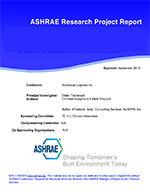
RP-641 — Duct Design Using the T-Method With Duct Leakage Incorporated
- Comments Off on RP-641 — Duct Design Using the T-Method With Duct Leakage Incorporated
- ASHRAE
Studies show that HVAC air duct systems are one of the major energy consumers in industrial and commercial buildings. Inefficient design of a duct system means that either energy is being wasted and/or excessive ductwork material is being installed. Duct system optimization offers the opportunity to realize significant owning and energy savings.
The new duct system optimization method, called T-Method. was developed as a result of cooperative research between ASHRAE and Fluor Daniel Corporation [ASHRAE 1988]. The purpose of this research activity was to develop a practical duct optimization procedure and conduct an economic analysis using the example in the ASHRAE 1985 Handbook as a reference. Life cycle cost is selected as the objective function. Constraints are pressure balancing, nominal duct sizes, preselected ducts, air velocity, and installation limitations. The T-Method duct design consists of three steps performed in series: system•condensing, fan selection, and system expansion. The papers “T-Method Duct Design, Part I and Part II” presents the theory of the method, step-by-step calculation procedures, economic analysis, and examples [Tsal et al. 1988]. A comprehensive explanation of each step with many examples confirm the practicality of the T-method.
Product Details
- Published:
- 1992
- Number of Pages:
- 199
- File Size:
- 1 file , 6.6 MB
- Product Code(s):
- D-RP-641

